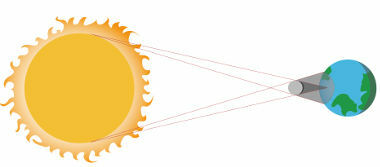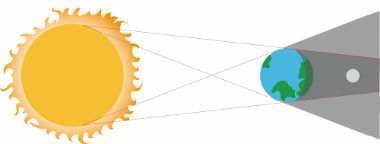Eclipse it is the total or partial dimming of a star made by interposing a second star in front of the light source. There are two types of eclipses: o solar it's the lunar.
It should be noted that both the lunar and solar eclipses depend on an alignment of the Earth's orbits around the Sun, and of the Moon, around the Earth; otherwise the phenomena will not occur.
solar eclipse
The solar eclipse occurs when the moon interposes itself between the Sun and the Earth, projecting its shadow over the Earth. In regions of the planet where the Sun is observed to be completely covered by the Moon, a so-called total solar eclipse occurs. Such regions are in the position of the shadow of the Moon. In places where the sun is not completely covered by the moon, a partial solar eclipse occurs, corresponding to the regions of dimness from the moon. If the Moon's orbit around the Earth were aligned with the Earth's orbit around the Sun, we would always have a solar eclipse during the New Moon phase.
Do not stop now... There's more after the advertising ;)

Moon between Sun and Earth
lunar eclipse
A lunar eclipse occurs when the Moon enters the Earth's shadow region, generated through the Sun's light, and the Earth's shadow covers the lunar disk. If the Moon's orbit around the Earth were to be aligned with the Earth's orbit around the Sun, we would always have a lunar eclipse during the Full Moon phase.

Moon in Earth's shadow region
Occurrence of the phenomenon
NASA provides calendars of eclipse occurrences. Click here and see when the next eclipse will be.
By Joab Silas
Graduated in Physics
Would you like to reference this text in a school or academic work? Look:
JUNIOR, Joab Silas da Silva. "What is an eclipse?"; Brazil School. Available in: https://brasilescola.uol.com.br/o-que-e/fisica/o-que-e-eclipse.htm. Accessed on June 27, 2021.

